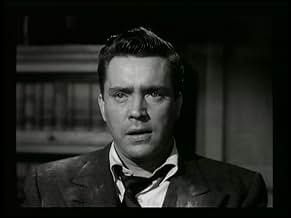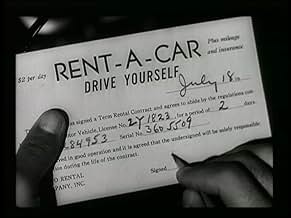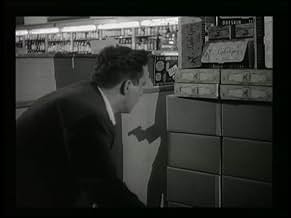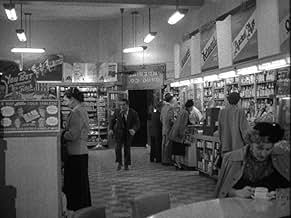AVALIAÇÃO DA IMDb
7,2/10
14 mil
SUA AVALIAÇÃO
Adicionar um enredo no seu idiomaFrank Bigelow, told he's been poisoned and has only a few days to live, tries to find out who killed him and why.Frank Bigelow, told he's been poisoned and has only a few days to live, tries to find out who killed him and why.Frank Bigelow, told he's been poisoned and has only a few days to live, tries to find out who killed him and why.
- Direção
- Roteiristas
- Artistas
- Prêmios
- 2 vitórias no total
Beverly Garland
- Miss Foster
- (as Beverly Campbell)
Cay Forester
- Sue
- (as Cay Forrester)
Frank Jaquet
- Dr. Matson
- (as Fred Jaquet)
Lawrence Dobkin
- Dr. Schaefer
- (as Larry Dobkin)
Bill Baldwin
- St. Francis Hotel Desk Clerk
- (não creditado)
Avaliações em destaque
Fans of film noir should see this one, as this film is up there with the best.
It's a story about how a simple act can lead to disaster in this case, death. If you've not seen it, I'm not about to tell you much except this: it has perhaps the most imaginative beginning for any murder mystery ever devised as Frank Bigelow (Edmond O'Brien) fronts up to the Homicide Bureau in Los Angeles to report a murder his own! Thereafter, the story traces Frank's attempts to find out who is trying to kill him, and why. One of the best pieces of irony is when, having learnt that he will die soon, Frank runs and runs until he's out of breath and stops, panting, beside a newsstand where there are multiple copies of Life magazine hanging there, just beside him. The director, Rudolph Mate, had a real insider joke with that shot.
And that long tracking shot, by the way, was an excellent example of how to use fast camera work and great editing.
On another level, the movie very much fits the times vis-à-vis the portrayal of evil and where it leads: retribution is always just around the corner for those who transgress society, even if you think you're justified. When you see this movie, you'll know what I mean.
And, for the times, the acting was good, with a standout performance from Edmond O'Brien, and ably supported by the ever-competent Luther Adler (as Majak, the sharp dealer in stolen goods), and Neville Brand, as the psychopathic Chester. The rest of the cast was adequate. The only jarring note (no pun intended) are the peculiar and bizarre wolf-whistles (inserted by some demented sound engineer?) that accompany Frank Bigelow as he looks at women in his hotel at San Francisco. What was the director thinking of...?
That aside, it's a good, fast-paced action mystery that helped to keep the film noir genre very much alive. Have a go...
It's a story about how a simple act can lead to disaster in this case, death. If you've not seen it, I'm not about to tell you much except this: it has perhaps the most imaginative beginning for any murder mystery ever devised as Frank Bigelow (Edmond O'Brien) fronts up to the Homicide Bureau in Los Angeles to report a murder his own! Thereafter, the story traces Frank's attempts to find out who is trying to kill him, and why. One of the best pieces of irony is when, having learnt that he will die soon, Frank runs and runs until he's out of breath and stops, panting, beside a newsstand where there are multiple copies of Life magazine hanging there, just beside him. The director, Rudolph Mate, had a real insider joke with that shot.
And that long tracking shot, by the way, was an excellent example of how to use fast camera work and great editing.
On another level, the movie very much fits the times vis-à-vis the portrayal of evil and where it leads: retribution is always just around the corner for those who transgress society, even if you think you're justified. When you see this movie, you'll know what I mean.
And, for the times, the acting was good, with a standout performance from Edmond O'Brien, and ably supported by the ever-competent Luther Adler (as Majak, the sharp dealer in stolen goods), and Neville Brand, as the psychopathic Chester. The rest of the cast was adequate. The only jarring note (no pun intended) are the peculiar and bizarre wolf-whistles (inserted by some demented sound engineer?) that accompany Frank Bigelow as he looks at women in his hotel at San Francisco. What was the director thinking of...?
That aside, it's a good, fast-paced action mystery that helped to keep the film noir genre very much alive. Have a go...
D. O. A. is an intriguing, fast paced movie, rife with metaphor. A mood of chaos and uncertain boundaries is introduced early in the film. At a hotel in San Francisco, businessman Frank Bigelow, seeking little more than the ephemeral pleasure of a brief trip, finds himself in the midst of party revelers. With unsettling frivolity, they roam randomly about their various guest rooms which appear unlocked and opened. The mood of strident, forced conviviality climaxes when they move the party to a local bar called "The Fisherman." As the jazz played in the venue intensifies in volume and rhythm, uneven camera angles catch the various musicians playing to the point that they're breaking sweat and literally, physically vibrating. Bigelow himself is jostled about in the crowd, actually losing his footing for a moment. The setting is that of a little world both frenzied and crazed. Bigelow appears detached as all react excitedly and emotionally to music that he admits isn't his taste.
This memorable key scene portends his disconnection from those around him and represents a crack, however slight, in his life's foundation. Though initially reticent about socializing and imbibing with people he just met, he has unwittingly been thrust into a reality more threatening than is immediately apparent. Later in the film, a jarring example of his full blown isolation occurs when he finds himself in an outdoor, public area. In unbearable turmoil, he momentarily encounters a little girl innocently playing with a toy. She appears in soft lighting, contrasting starkly to the shadows surrounding Bigelow, whose face registers the painful shock of awareness that ordinary activity continues unabated even while he grapples with extreme danger. This is reinforced when seconds later he observes a young couple embracing, compounding his agonizing realization that all simple pleasures are now unattainable to him. Noticeably, when he is literally "up against the wall" his back is touching signage of "Life Magazine" logos. All that once comprised his own life, that which he had considered to be little more than mundane minutiae, is heightened in significance and irrevocably at stake.
This memorable key scene portends his disconnection from those around him and represents a crack, however slight, in his life's foundation. Though initially reticent about socializing and imbibing with people he just met, he has unwittingly been thrust into a reality more threatening than is immediately apparent. Later in the film, a jarring example of his full blown isolation occurs when he finds himself in an outdoor, public area. In unbearable turmoil, he momentarily encounters a little girl innocently playing with a toy. She appears in soft lighting, contrasting starkly to the shadows surrounding Bigelow, whose face registers the painful shock of awareness that ordinary activity continues unabated even while he grapples with extreme danger. This is reinforced when seconds later he observes a young couple embracing, compounding his agonizing realization that all simple pleasures are now unattainable to him. Noticeably, when he is literally "up against the wall" his back is touching signage of "Life Magazine" logos. All that once comprised his own life, that which he had considered to be little more than mundane minutiae, is heightened in significance and irrevocably at stake.
Frank Bigelow: "I want to report a murder." Homicide Captain: "Where was this murder committed?" Frank Bigelow: "San Francisco, last night." Homicide Captain: "Who was murdered?" Frank Bigelow: "I was."
It must be the dream of all directors to open a film with a scene or line which carries great impact and remains in the memory. The opening line in D.O.A must rank among the most dramatically effective and intriguing lines that has ever opened a movie. This is the quintessential film noir. Edmond O'Brien as the tough, hard drinking businessman who has grown tired of the normalcy of his life and the clinging Paula. His holiday in San Francisco is an opportunity to break the shackels. The premise that the hero has been given a slow poison for which there is no cure, and only a day or so to solve his own murder before he dies, is exceptional. We also have an array of sultry "bad girls", a seedy villain and a manic hitman. Rudoph Mate directs brilliantly, not missing a moment to twist and turn the action at a fast pace with no dull moments. Scenes of O'Brien running through city streets after he has learned his fate are superb with incredibly realistic wide shots. The fact that his direction is so effective makes one wonder how he could have allowed the lapses of ridiculous canned "wolf whistles" whenever the hero passed a good looking girl in the early scenes. Although these "wolf whistles" are really out of place and very annoying, the film is so effective that we can forgive the indiscretion. This is a classic example of a brilliant plot superbly told in a way that is still gripping 50 years after it was made. D.O.A. defines Film Noir.
It must be the dream of all directors to open a film with a scene or line which carries great impact and remains in the memory. The opening line in D.O.A must rank among the most dramatically effective and intriguing lines that has ever opened a movie. This is the quintessential film noir. Edmond O'Brien as the tough, hard drinking businessman who has grown tired of the normalcy of his life and the clinging Paula. His holiday in San Francisco is an opportunity to break the shackels. The premise that the hero has been given a slow poison for which there is no cure, and only a day or so to solve his own murder before he dies, is exceptional. We also have an array of sultry "bad girls", a seedy villain and a manic hitman. Rudoph Mate directs brilliantly, not missing a moment to twist and turn the action at a fast pace with no dull moments. Scenes of O'Brien running through city streets after he has learned his fate are superb with incredibly realistic wide shots. The fact that his direction is so effective makes one wonder how he could have allowed the lapses of ridiculous canned "wolf whistles" whenever the hero passed a good looking girl in the early scenes. Although these "wolf whistles" are really out of place and very annoying, the film is so effective that we can forgive the indiscretion. This is a classic example of a brilliant plot superbly told in a way that is still gripping 50 years after it was made. D.O.A. defines Film Noir.
DOA was made on the cusp of Edmond O'Brien's transition from leads to character roles and it may very well be his career part.
It's a cheaply made thriller and it shows in spots. But it more than makes up for it in originality of plot and the performances of a superb cast of players.
DOA involves nothing less than Edmond O'Brien solving his own murder. He's in some kind of business and as a sideline he makes a little extra money as a notary. He notarizes a bill of sale and in doing so is a witness to a piece of evidence that a man who was a party to the sale had no reason to commit suicide.
But the perpetrator doesn't slip O'Brien something fast acting like cyanide. No he gets something called luminescent poisoning which is slow acting, but irreversibly fatal if not caught within a few hours of ingesting. When he learns what happens, O'Brien has nothing to lose in his hunt for his own killer.
Best in the cast of supporting players without a doubt is Neville Brand who invades Lyle Bettger territory in playing a psychopathic thug in Luther Adler's employ. Adler himself is always good as are good girl Pamela Britton and bad girl Beverly Garland.
The film was made on a shoestring, but occasionally those films can prove worthwhile.
It's a cheaply made thriller and it shows in spots. But it more than makes up for it in originality of plot and the performances of a superb cast of players.
DOA involves nothing less than Edmond O'Brien solving his own murder. He's in some kind of business and as a sideline he makes a little extra money as a notary. He notarizes a bill of sale and in doing so is a witness to a piece of evidence that a man who was a party to the sale had no reason to commit suicide.
But the perpetrator doesn't slip O'Brien something fast acting like cyanide. No he gets something called luminescent poisoning which is slow acting, but irreversibly fatal if not caught within a few hours of ingesting. When he learns what happens, O'Brien has nothing to lose in his hunt for his own killer.
Best in the cast of supporting players without a doubt is Neville Brand who invades Lyle Bettger territory in playing a psychopathic thug in Luther Adler's employ. Adler himself is always good as are good girl Pamela Britton and bad girl Beverly Garland.
The film was made on a shoestring, but occasionally those films can prove worthwhile.
**SPOILERS** Staggering into a L.A police station barely alive Frank Bigelow, Edmound O'Brien, has a story to tell about a murder that he witnessed, his own! It all happened two days ago when Bigelow was straying in San Francisco on vacation from his job as a tax accountant during Market Week. At the Fisherman Club Bigelow got a bit juiced up and during drinks he was slipped a dose of luminous toxin in his glass. It's that toxin that's now on the verge of killing him. The reason that he was poisoned had to do with him notarizing a bill of sale for a shipment of iridium that was stolen and could put the person who shipped it behind bars for at least five years!
It took a while for Bigelow to realize that he had a fatal dose of luminous toxin in his system and by the time he did it was too late to save his life. But it wasn't too late for Bigelow to track down and find the person or persons who had him poisoned. And it's during the rest of the movie, in flashback, that's exactly what he did! And did it with an unrelenting fury as if his life depended on it!
In what is undoubtedly Edmound O'Brien's best role as Frank "Biggie" Bigeow the film "D.O.A" has him move heaven and earth to find the person who eventually murdered him. From San Francisco to Los Angeles as well as parts in between Bigelow finally track him down to the Philips Inport-Export office at the Bradbury Building in downtown L.A. It in fact was Philips who was murdered, by being thrown to his death, because of the illegal iridium shipment that he later realized he was tricked into handling. With Philips dead the only person who could connect both his murderer and the person whom he shipped the iridium for is Frank Bigelow who handled, by notarizing the bill of sale, the shipment!
Non stop action thriller as a dying, or murdered, man turns L.A upside down in trying to find his killer and exact punishment on him before he himself expires! Bigelow also gets involved with L.A mobster Majak, Luther Adler, whom the illegal iridium was delivered for. In knowing about Majak's involvement in it had Bigelow targeted by him and his sadistic and unstable hit man Chester, Naville Brand, for immediate termination. That's if the luminous toxin doesn't kill him first!
Even though the movie is a scant 83 minutes long it packs enough action to fill some half dozen films of it's type: Film Noir Thrillers. Frank Bigelow is a man who knows that he hasn't long to live and therefore throws caution to the wind in trying to find his killer before the curtain comes down on him. It was in fact that almost suicidal determination on Bigelow's part that in the end brought him results!
It took a while for Bigelow to realize that he had a fatal dose of luminous toxin in his system and by the time he did it was too late to save his life. But it wasn't too late for Bigelow to track down and find the person or persons who had him poisoned. And it's during the rest of the movie, in flashback, that's exactly what he did! And did it with an unrelenting fury as if his life depended on it!
In what is undoubtedly Edmound O'Brien's best role as Frank "Biggie" Bigeow the film "D.O.A" has him move heaven and earth to find the person who eventually murdered him. From San Francisco to Los Angeles as well as parts in between Bigelow finally track him down to the Philips Inport-Export office at the Bradbury Building in downtown L.A. It in fact was Philips who was murdered, by being thrown to his death, because of the illegal iridium shipment that he later realized he was tricked into handling. With Philips dead the only person who could connect both his murderer and the person whom he shipped the iridium for is Frank Bigelow who handled, by notarizing the bill of sale, the shipment!
Non stop action thriller as a dying, or murdered, man turns L.A upside down in trying to find his killer and exact punishment on him before he himself expires! Bigelow also gets involved with L.A mobster Majak, Luther Adler, whom the illegal iridium was delivered for. In knowing about Majak's involvement in it had Bigelow targeted by him and his sadistic and unstable hit man Chester, Naville Brand, for immediate termination. That's if the luminous toxin doesn't kill him first!
Even though the movie is a scant 83 minutes long it packs enough action to fill some half dozen films of it's type: Film Noir Thrillers. Frank Bigelow is a man who knows that he hasn't long to live and therefore throws caution to the wind in trying to find his killer before the curtain comes down on him. It was in fact that almost suicidal determination on Bigelow's part that in the end brought him results!
Você sabia?
- CuriosidadesThe scene in which Bigelow runs in panic through the streets after learning he has been poisoned was what is considered a 'stolen shot' where the pedestrians along the sidewalk had no idea a movie was being made and no warning that Edmond O'Brien would be plowing through them.
- Erros de gravaçãoAfter finding out who's in the photo, Bigelow leaves the photography studio and immediately starts getting shot at. He heads toward the factory (screen right) where the shots are supposed to be coming from, but all the shots being fired and ricocheting off the ground, pipe, barrel, etc. are coming from the other direction (screen left).
- Citações
[first lines]
Homicide Detective: Can I help you?
Frank Bigelow: I'd like to see the man in charge.
Homicide Detective: In here...
Frank Bigelow: I want to report a murder.
Homicide Captain: Sit down. Where was this murder committed?
Frank Bigelow: San Francisco, last night.
Homicide Captain: Who was murdered?
Frank Bigelow: I was.
- Cenas durante ou pós-créditosThe end credits read "The medical facts in this motion picture are authentic. Luminous toxin is a descriptive term for an actual poison. Technical Adviser, Edward F. Dunne, M.D."
- Versões alternativasAlso available in a colorized version.
Principais escolhas
Faça login para avaliar e ver a lista de recomendações personalizadas
- How long is D.O.A.?Fornecido pela Alexa
Detalhes
- Data de lançamento
- País de origem
- Idioma
- Também conhecido como
- Con las horas contadas
- Locações de filme
- Empresas de produção
- Consulte mais créditos da empresa na IMDbPro
- Tempo de duração
- 1 h 23 min(83 min)
- Cor
- Proporção
- 1.37 : 1
Contribua para esta página
Sugerir uma alteração ou adicionar conteúdo ausente





































